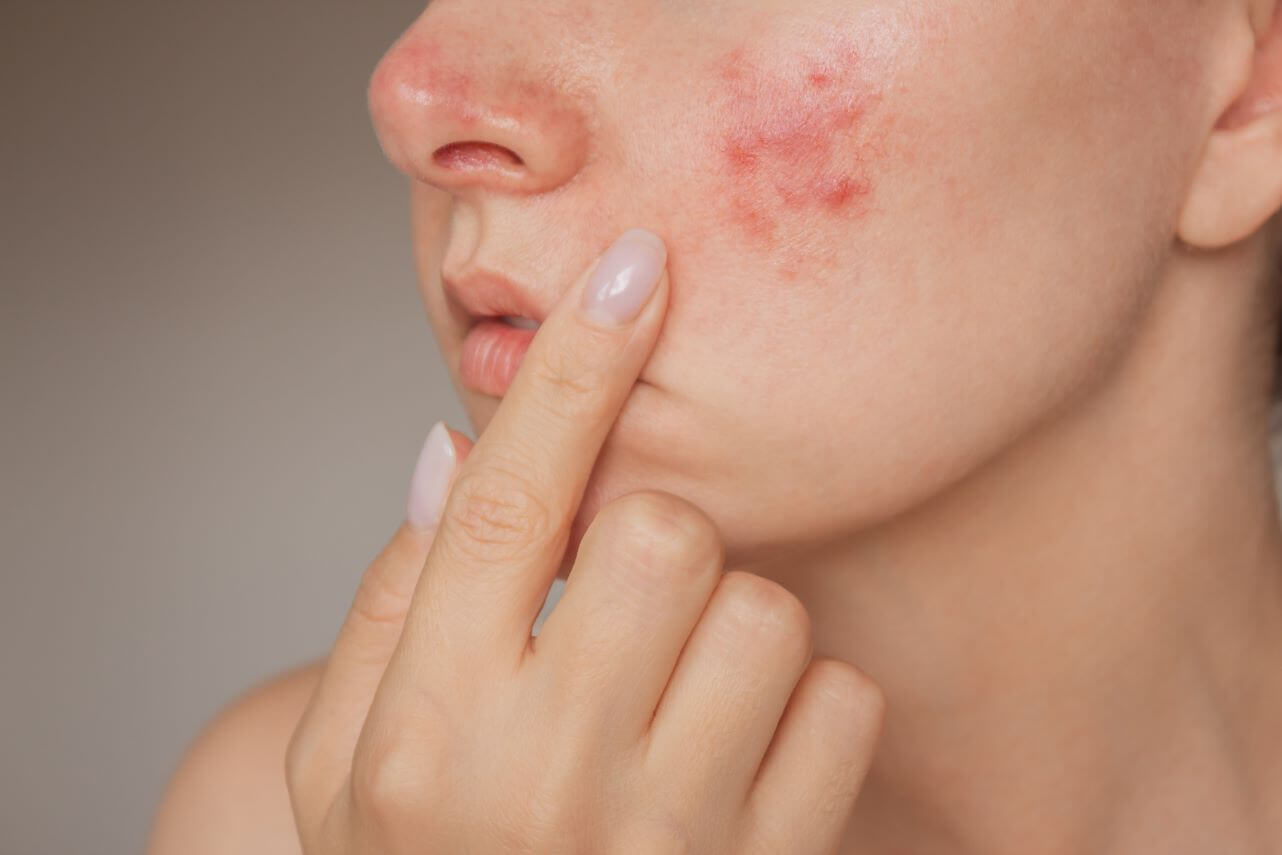Rosacea and acne are two common skin conditions that people frequently confuse. According to Dr. Paul Curtiss of U.S. Dermatology Partners in Carrollton, Texas, “The clinical name for acne is acne vulgaris, and it may closely resemble a form of rosacea, acne rosacea. The names alone make it clear that both conditions may closely resemble each other. While rosacea and acne may share some symptoms and appearances, key differences make it important to receive an accurate diagnosis and develop a treatment plan with a dermatologist in order to achieve excellent short and long-term results.” In this blog, Dr. Curtiss walks through the differences between acne and rosacea as well as the most recommended treatments and daily skincare tips to manage both conditions.
What Is Acne?
Acne vulgaris, typically referred to as just acne, is a common, chronic skin condition that occurs when the pores are clogged with dead skin cells, oils, and other materials, resulting in inflammation and infection. The clogged pores cause open and closed comedones that you may have heard referred to as blackheads and whiteheads respectively. The cause of this condition varies. Explaining acne causes, Dr. Curtiss says, “The teen years bring changes in hormone production, and this is often the first time that people experience acne breakouts. It is named after the bacteria, C. Acnes, which at low levels of oil production live on the surface of the skin. In cases of acne, however, increased oil production due to hormones, clogged pores, or other causes allows the bacteria to multiply and grow. This may stimulate an immune reaction, where the immune system attacks the bacteria, leading to conventional pimples.”
What Is Rosacea?
Acne rosacea, which is commonly called rosacea, is an inflammatory skin condition that may cause skin redness, inflammation, and deep blemishes called papules and pustules. Rosacea is often linked to genetics or immune system dysfunction, but the cause of this relapsing skin condition isn’t completely clear. The condition often will characteristically worsen over time with increased sun exposure. Periodically, different triggers may lead to rapid worsening or flaring of the disease. Some triggers are known to be common catalysts for flare-ups, including sunlight, high temperatures, drinking alcohol or caffeine, eating spicy foods, and experiencing strong emotions.
Importantly, some people suffer from a form of rosacea that is dominated by blood vessels and increased redness or flushing. They may or may not have bumps that resemble acne, but they should also avoid excess sun exposure.
Similarities That Cause Confusion
Discussing similarities between rosacea and acne, Dr. Curtiss said, “Both conditions may cause redness, bumps, and pustules that essentially resemble pimples. Especially in the early stages of a flare-up, the conditions of acne and rosacea are almost identical. If you’ve never experienced either condition, it’s important to visit a dermatologist to ensure you receive an accurate diagnosis. This will also allow you to develop a plan to manage these conditions and address flare-ups and breakouts, ensuring you heal with less discomfort.”
Key Differences Between Rosacea and Acne
According to Dr. Curtiss, “It doesn’t surprise me that so many people get these two conditions mixed up. They do share many similarities. In order to make a diagnosis, I carefully examine my patients looking for the key differences.”
Some of the differences between acne and rosacea symptoms include:
| ROSACEA | ACNE |
| Inflamed papules and pustules with largely absent “comedones” or clogged pores. | Surface-level clogged pores, called open and closed comedones as well as deeper cysts and nodules. |
| General redness and inflammation on the face, especially the forehead, nose, cheeks, and chin. Often more predominant in sun-exposed areas | Redness and inflammation are typically more central around pimples |
| Uneven skin texture, increased enlarged oil glands, and visible blood vessels. | Oily skin and bumpy texture with relatively normal background blood vessels. |
| Symptoms focused on the face in sun-exposed areas, but the redness may extend during flare-ups to impact the scalp, neck, shoulders, back, or chest. | Symptoms can be widespread, but they are most common on the face, chin, neck, shoulders, back, and chest. |
| Swollen, red, and bloodshot eyes. | Should not impact eye health. |
| Skin sensitivity to skincare products with reactive burning, stinging, or itching. | Unlikely to experience allergic response to skincare products, but certain products may trigger a breakout. |
| The condition often worsens slowly over time. Many will develop this condition after the age of 30. | Most common among teens and tweens, but some younger children and adults also develop this condition. It may improve over time. |
Diagnosing Rosacea and Acne
A diagnosis from a dermatologist ensures you can create the right skincare routine to manage rosacea or acne and seek appropriate treatments for these conditions. Dr. Curtiss says, “Without a diagnosis, patients can pursue the wrong treatments. Attempting to treat rosacea with acne products can lead to irritation and exacerbate the symptoms, making flare-ups last longer. Treating acne breakouts with skincare products geared toward rosacea may not be effective in reducing oiliness and clearing pores. Early intervention and accurate diagnosis is critical, as both these conditions may lead to scarring over time.” Because of the risk of improper treatment, it’s essential to work with a dermatology expert to receive an accurate diagnosis and treatment plan.
Treatment Options for Acne
Some of the most common acne treatment options include:
- Antibiotics – Removing bacteria on the skin reduces the risk of inflammation and infection in the pores that cause blemishes.
- Hormonal treatments – These prescription medications are often recommended to undo the negative effects that hormonal changes have on the skin, leading to acne breakouts.
- Laser therapy – May be recommended to address individual blemishes or clear up acne scarring and discoloration.
- Isotretinoin – When other treatments aren’t effective, this vitamin A-derived oral medication may be prescribed. Due to the severe potential side effects, it is only used under very strict protocols for a short time.
Treatment Options for Rosacea
Some of the most common treatments for rosacea include:
- Anti-inflammatory medications – Usually creams, applied directly to the skin, but oral anti-inflammatory medications may also be prescribed.
- Oral antibiotics – To help clear up painful, infected papules and pustules, the dermatologist may prescribe oral antibiotics.
- Brimonidine or oxymetazoline – Topical medications applied to the face to constrict blood vessels and reduce facial redness.
- Laser treatment – Laser light treatments can be used to decrease the appearance of enlarged pores, blood vessels, and skin redness.
Managing Both Conditions
Whether you have acne or rosacea, Dr. Curtiss says, “A consistent skincare routine is essential. It doesn’t have to be overly complicated, but it does need to include products with quality ingredients that are formulated to address your specific skin conditions. A dermatologist can help you find the ideal products for your unique skincare needs. In addition to creating and maintaining a consistent skincare routine, it’s important to track symptoms to determine potential triggers for a flare-up, so you can avoid these items.”
Discuss Your Outlook & Treatment Options with a Professional
While acne and rosacea can be treated with the right skincare products at home, it’s essential to receive an accurate diagnosis and develop the right routine in partnership with a dermatologist to manage these conditions. By working with a dermatologist, you can develop a treatment plan to manage acne or rosacea and keep the skin looking and feeling its best.
Get Started Today
If you’re unsure about your skin condition, reach out to a dermatologist today to gain clarity and begin your journey to healthier skin. Whenever you’re ready to get started, the U.S. Dermatology Partners team makes it easy to schedule your visit. Simply take a few moments to complete our online scheduling request form. Once we hear from you, a team member will be in touch to finalize the details of your visit.
Find a location near me
or


